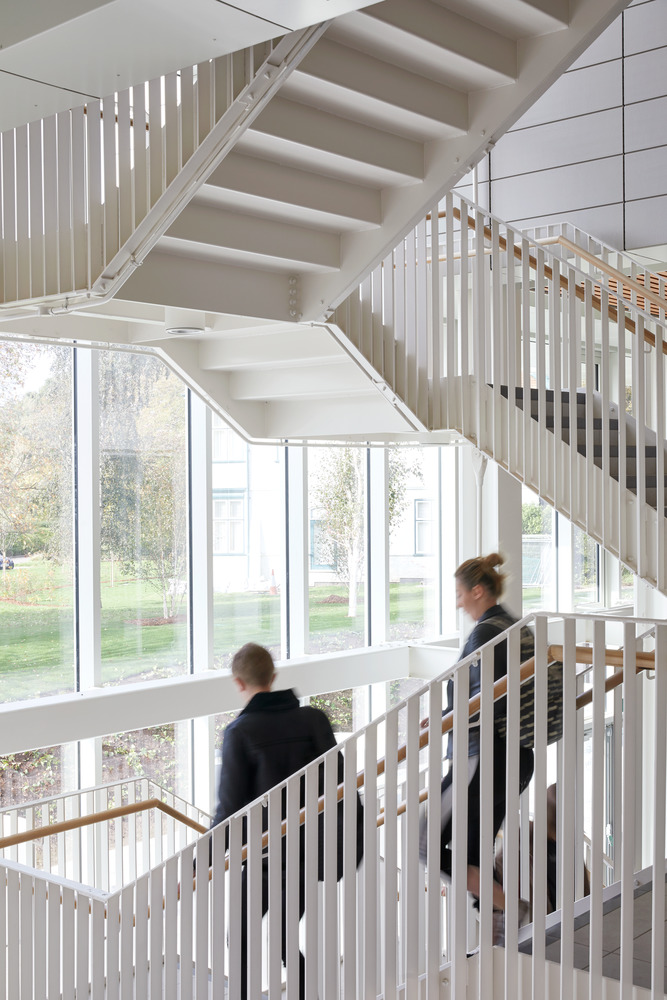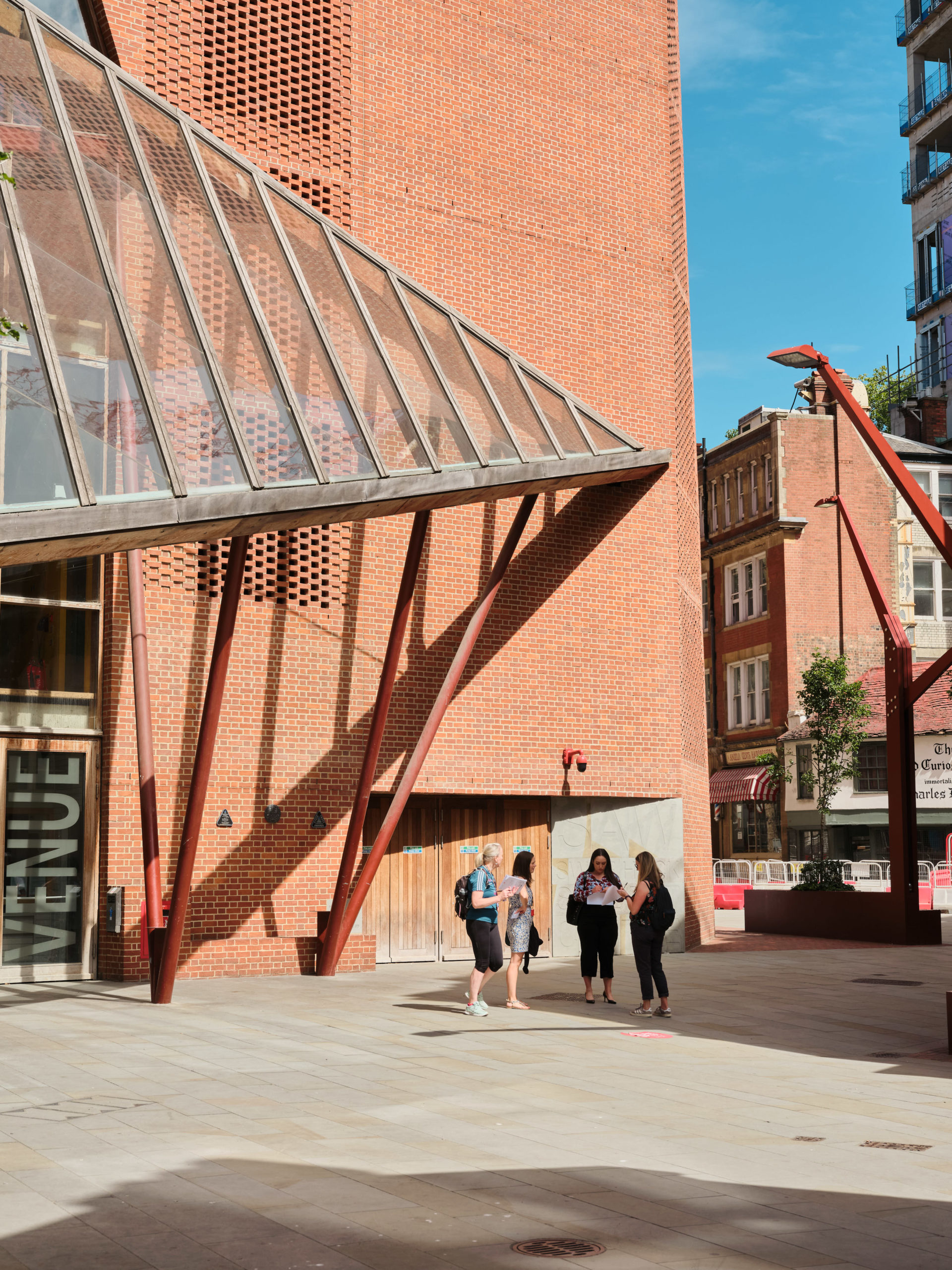
Knowledge Exchange and
Social Connection
by Ziona Strelitz, Founder Director, ZZA Responsive User Environments
Writing this midst the COVID-19 hiatus, one inevitably speculates on how the world is going to be. I see this disruptive event as highlighting knowledge exchange and social connection as key aspects of higher education design that will emerge as even more important as we move forward.
My work involves research and strategy – generating evidence on how people use and experience buildings and spaces, and leveraging the deep and continuously evolving insight that accrues from this to help inform new design projects.
Sectoral crossovers
An aspect of my practice that provides particular value is learning from ZZA’s work across different sectors. This spawns design ideas and user protocols that can be usefully transferred from one sector to another, in either a similar or adapted form, as appropriate. Among the sectors we cover, the crossovers between academic and commercial environments have increasingly converged.
It’s not uncommon for people to consider the established work milieu in their respective sector as a special case, and academics have continued to be unwavering about individual, assigned offices being essential to their work as researchers, tutors, pastoral carers and colleagues. And until COVID forcefully zoomed them en masse onto online modes of student engagement, many have also held firm on traditional modes of teaching as the only real possibility.
But requirements are often less specific than assumed, and despite academics’ long-standing success in retaining their offices, the context of academia has been changing all the while. How could it have been otherwise, with the locational flexibility and cultural change that technology has brought to social and economic functioning across the board? And especially as academic work is highly characterised by autonomy and agility – faculty have extensive discretion over significant parts of their activity, spatially and temporally.
My work involves research and strategy – generating evidence on how people use and experience buildings and spaces, and leveraging the deep and continuously evolving insight that accrues from this to help inform new design projects.
Sectoral crossovers
An aspect of my practice that provides particular value is learning from ZZA’s work across different sectors. This spawns design ideas and user protocols that can be usefully transferred from one sector to another, in either a similar or adapted form, as appropriate. Among the sectors we cover, the crossovers between academic and commercial environments have increasingly converged.
It’s not uncommon for people to consider the established work milieu in their respective sector as a special case, and academics have continued to be unwavering about individual, assigned offices being essential to their work as researchers, tutors, pastoral carers and colleagues. And until COVID forcefully zoomed them en masse onto online modes of student engagement, many have also held firm on traditional modes of teaching as the only real possibility.
But requirements are often less specific than assumed, and despite academics’ long-standing success in retaining their offices, the context of academia has been changing all the while. How could it have been otherwise, with the locational flexibility and cultural change that technology has brought to social and economic functioning across the board? And especially as academic work is highly characterised by autonomy and agility – faculty have extensive discretion over significant parts of their activity, spatially and temporally.
In terms of design, the strongest programmatic alignment between commercial workspace and higher education is promoting knowledge transfer. Whereas the acquisition and imparting of knowledge has always been the rationale of universities, it is now also seen as the heart of business – both private and public sector. Organisations’ quest for new ideas and their need for resilience require their people to share knowledge. Physical spaces that promote this are viewed as important enablers. Having contributed to numerous workplace strategies and judged many workplace awards, I know first-hand that organisations consistently cite knowledge transfer as an objective for procuring new workspace, with their business case invariably geared to this end.
The distinguishing feature of workplace design for knowledge transfer is space to promote physical encounters and interaction, based on the expectation that this will lead to social engagement, information exchange and added value. Indeed, review of space budgets of commercial workplaces over recent decades evidences a very clear shift from space for solo working to settings that facilitate interaction – spaces to convene, present, discuss and chat. In contrast to the previous workplace focus on corridors lined with formal meeting rooms, which now seems so ‘last century’, the new social settings typically comprise a diverse range of informal environments that look lively and are more inviting and stimulating to use.
More recently, this approach has infused higher education. The contemporary focus on social learning has established a striking physical presence on university campuses, and social learning has become forceful in steering the settings that academic institutions now look to provide.
Why learning together benefits learning
Learning with others involves various degrees and forms of togetherness. Group discussions and joint presentations are perhaps the most obvious and active collaborative modes, but people frequently learn together seated in pairs, and often this involves study partners pursuing entirely different subject areas from one another. The stimulus they want is to feel motivated by other people who are also learning, and to counter a sense of isolation while pursuing individual study. ZZA identified these powerful motivators in our research on Why Place Still Matters in the Digital Age, reporting the scenario of student friends – taking degrees in non-cognate domains at different universities – coming to support each other in independent study at the British Library. And we’ve observed the range of social learning formats in action again and again over the decade, most recently in our post-occupancy research at the London School of Economics’ highly popular new Centre Building, with its expansive Learning Commons, which offers a range of study settings.
Social space as the fulcrum
The distinguishing feature of workplace design for knowledge transfer is space to promote physical encounters and interaction, based on the expectation that this will lead to social engagement, information exchange and added value. Indeed, review of space budgets of commercial workplaces over recent decades evidences a very clear shift from space for solo working to settings that facilitate interaction – spaces to convene, present, discuss and chat. In contrast to the previous workplace focus on corridors lined with formal meeting rooms, which now seems so ‘last century’, the new social settings typically comprise a diverse range of informal environments that look lively and are more inviting and stimulating to use.
More recently, this approach has infused higher education. The contemporary focus on social learning has established a striking physical presence on university campuses, and social learning has become forceful in steering the settings that academic institutions now look to provide.
Why learning together benefits learning
Learning with others involves various degrees and forms of togetherness. Group discussions and joint presentations are perhaps the most obvious and active collaborative modes, but people frequently learn together seated in pairs, and often this involves study partners pursuing entirely different subject areas from one another. The stimulus they want is to feel motivated by other people who are also learning, and to counter a sense of isolation while pursuing individual study. ZZA identified these powerful motivators in our research on Why Place Still Matters in the Digital Age, reporting the scenario of student friends – taking degrees in non-cognate domains at different universities – coming to support each other in independent study at the British Library. And we’ve observed the range of social learning formats in action again and again over the decade, most recently in our post-occupancy research at the London School of Economics’ highly popular new Centre Building, with its expansive Learning Commons, which offers a range of study settings.
This physical coming together, face to face, offers an immediacy of engagement that outstrips remote connection. It’s not that virtual platforms aren’t valuable. Indeed, how much more disconnected would we all have been during COVID-19 without them? Like others, I’ve made extensive use of online connection over the pandemic’s lockdown. But none has given me more benefit than a face-to-face encounter – eyeball to eyeball, helping me to discern and respond to co-participants’ gestures, pace and other cues in real time, all of which are important nuggets in registering a fuller picture. Not even my clients whose business is to sell technologies for virtual connection doubt that the ready availability of someone to tap on the shoulder, and the osmotic learning from being in earshot, trumps having to contact someone who is remote to ask a non-urgent question.
Social connection as important in itself
There’s more to convening with others in physical space than the instrumentality of better learning or knowledge transfer, pivotal though that is. We don’t go to university or the office just to work; sociability in itself is a big attractor. The COVID laboratory has reinforced our recognition of social contact as a driver, whether for work or study. We value live company – a chat, a hug, a community beyond our household, an active arena in which to define ourselves. People want this. The office isn’t dead. Nor are universities as we’ve known them obsolete in real life. Indeed, the role of sociability in combatting loneliness and poor mental health has attracted widespread attention.
Social connection as important in itself
There’s more to convening with others in physical space than the instrumentality of better learning or knowledge transfer, pivotal though that is. We don’t go to university or the office just to work; sociability in itself is a big attractor. The COVID laboratory has reinforced our recognition of social contact as a driver, whether for work or study. We value live company – a chat, a hug, a community beyond our household, an active arena in which to define ourselves. People want this. The office isn’t dead. Nor are universities as we’ve known them obsolete in real life. Indeed, the role of sociability in combatting loneliness and poor mental health has attracted widespread attention.
Quo vadis?
Based on the compelling appeal and benefits of social settings in commercial workplaces and universities, I foresee no diminishing interest in physical spaces to promote knowledge and learning. But this begs the question of the business model for onward development of higher education buildings. Student numbers, and students from abroad, have played a significant part in funding the construction of the new learning environments that have won acclaim – those social spaces that photograph so attractively and in turn serve as powerful posters for their campuses. With social learning in physical settings a potent ingredient that helps fuel higher education’s attractiveness and effectiveness, full migration to online learning is not going to be the answer. But with capital expenditure and revenue budgets dramatically squeezed, resourcing of even slowed-down development programmes will be a challenge. COVID’s financial hit to universities and businesses can’t be magicked away, so what does the future bode?
Institutions may be in a catch-22, but their lifeblood is indispensable. For higher education, this means students and staff; and of these two constituencies, it’s students who have more agility and room for manoeuvre in where they choose to go. Their selection of university is a nimbler decision than an academic considering a switch of employer, so students’ interest is poised to have the stronger clout. A positive aspect of economic crises is the visibility they give to redundancies. I predict that future priorities for higher education accommodation will reflect a rebalancing of space budgets, with the slack that now resides in under-occupied academic offices making way for more student learning space.
And with a likely moratorium on brave new buildings, existing space will be released for adaptive reuse. ZZA’s study of LSE Life, the innovative curated learning environment in the LSE Library, evidenced its game-changing effectiveness for students – in a retrofit. With its stripped-back interior and exposed services, the space itself is atypical in the LSE campus context. What so hit a note with students were its readily available study spaces for individuals and groups, the scope to talk while studying, and the provision of expert assistance in learning skills, offered on the spot.
Retrofitting higher education facilities can be part of a rich seam, incorporating a relevant variety of study settings. But I have no doubt that when the ‘new normal’ emerges, higher education will re-mobilise to procure more new environments that promote learning and knowledge transfer. Base building design is uniquely poised to optimise this. ZZA’s research on Make Architects’ Teaching and Learning Building at the University of Nottingham evidences the positive influence of its human scale, excellent daylight and external views in helping students study effectively and for long periods. Importantly, technology will be there too, in the mix with physical space, supporting all participants in their preferred approaches to blended teaching and learning.
Win-win-win
And I venture that faculty will also benefit. As in any squeeze that drives innovation, academics will be led to varied new work settings akin to the suite of environments that commercial workspace has offered for two decades, predicated on what were called ‘new ways of working’ when office workers were first untethered from their desks. Academic workspace will catch up, if not leapfrog, with thoughtful design to align with academics’ needs – in its conception, realisation and testing of use. So integral to future gains for students and faculty, I foresee a likely win for designers too, as collaborators in delivering buildings and spaces that will help universities continue to flourish.
![Teaching and Learning Building.]()
![LSE’s Saw Swee Hock Student Centre. Photograph Polly Tootal]()
Win-win-win
And I venture that faculty will also benefit. As in any squeeze that drives innovation, academics will be led to varied new work settings akin to the suite of environments that commercial workspace has offered for two decades, predicated on what were called ‘new ways of working’ when office workers were first untethered from their desks. Academic workspace will catch up, if not leapfrog, with thoughtful design to align with academics’ needs – in its conception, realisation and testing of use. So integral to future gains for students and faculty, I foresee a likely win for designers too, as collaborators in delivering buildings and spaces that will help universities continue to flourish.


